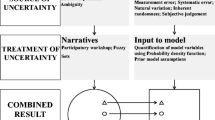Abstract
In this paper we present an uncertainty analysis of a cross-sectoral, regional-scale, Integrated Assessment Platform (IAP) for the assessment of climate change impacts, vulnerability and adaptation. The IAP couples simplified meta-models for a number of sectors (agriculture, forestry, urban development, biodiversity, flood and water resources management) within a user-friendly interface. Cross-sectoral interactions and feedbacks can be evaluated for a range of future scenarios with the aim of supporting a stakeholder dialogue and mutual learning. We present a method to address uncertainty in: i) future climate and socio-economic scenarios and ii) the interlinked network of meta-models that make up the IAP. A mixed-method approach is taken: formal numerical approaches, modeller interviews and network analysis are combined to provide a holistic uncertainty assessment that considers both quantifiable and un-quantifiable uncertainty. Results demonstrate that the combined quantitative-qualitative approach provides considerable advantages over traditional, validation-based uncertainty assessments. Combined fuzzy-set methods and network analysis methods allow maps of modeller certainty to be explored. The results indicate that validation statistics are not the only factors driving modeller certainty; a large range of other factors including the quality and availability of validation data, the meta-modelling process, inter-modeller trust, derivation methods, and pragmatic factors such as time, resources, skills and experience influence modeller certainty. We conclude that by identifying, classifying and exploring uncertainty in conjunction with the model developers, we can ensure not only that the modelling system itself improves, but that the decisions based on it can draw on the best available information: the projection itself, and a holistic understanding of the uncertainty associated with it.



Similar content being viewed by others
Notes
Coastal flooding is unchanged as the sea-level variable is constant across the climate scenarios.
References
Audsley E, Pearn KR, Harrison PA, Berry PM (2008) The impact of future socio-economic and climate changes on agricultural land use and the wider environment in East Anglia and NorthWest England using a meta-model system. Clim Chang 90:57–88
Beven (2012) Environmental modelling—an uncertain future. CRC press, 328 pp
FCMapper (2012) FCMapper—our Fuzzy Cognitive Mapping Software Solution. Online resource: http://www.fcmappers.net/joomla/index.php?option=com_content&view=article&id=52&Itemid=53. Accessed 17 Sept 2012
Gramberger et al (2011) Report on the first CLIMSAVE European stakeholder workshop. Available online at: www.CLIMSAVE.eu. Accessed 12 Feb 2014
Gramberger et al (2013) Report on the third CLIMSAVE European stakeholder workshop. Available online at: www.CLIMSAVE.eu. Accessed 12 Feb 2014
Harrison PA et al (2013) Combining qualitative and quantitative understanding for exploring cross-sectoral climate change impacts, adaptation and vulnerability in Europe. Reg Environ Chang 13(4):761–780
Holman IP et al (2008) The concepts and development of a participatory regional integrated assessment tool DOI:10.1007/s10584-008-9453-6#View article on Climatic Change website. Clim Chang 90(1–2):5–30
IPCCDDC (2010) IPCC data delivery centre, AR4 GCM data. Online datasource. Accessed 17 Sept 2012: http://www.mad.zmaw.de/IPCC_DDC/html/SRES_AR4/index.html
Kok K (2009) The potential of Fuzzy Cognitive Maps for semi-quantitative scenario development, with an example from Brazil. Glob Environ Chang 19:122–133
Kok K et al (2013) Report on the new methodology for scenario analysis, including guidelines for its implementation, and based on an analysis of past scenario exercises. CLIMSAVE Deliverable 3.1. Available online at: www.CLIMSAVE.eu. Accessed 12 Feb 2014
Latour, Woolgar (1979) Laboratory life: the construction of scientific facts. Princetown University Press, Princetown
Manning LJ et al (2009) Using probabilistic climate change information from a multi-model ensemble for water resources assessment. Water Resour Res 45, W11411. doi:10.1029/2007WR006674
Mitchell TD, Carter TR, Jones PD, Hulme M, New M (2003) A comprehensive set of climate scenarios for Europe and the globe. Tyndall Centre Working Paper 55
Mokrech M et al (2008) Regional impact assessment of flooding under future climate and socio-economic scenarios for East Anglia and North West England. Clim Chang 90:31–55
Monserud RA, Leemans R (1992) Comparing global vegetation maps with the kappa statistic. Ecol Model 62:275–293
Pajek (2012) Pajek—program for large network analysis. Online resource available at: http://pajek.imfm.si/doku.php?id=pajek. Accessed 17 Sept 2012.
Rounsevell MDA, Metzger MJ (2010) Developing qualitative scenario storylines for environmental change assessment. Wiley Interdiscip Rev Clim Chang 1:606–619
Swets JA (1988) Measuring the accuracy of diagnostic systems. Science 240:1285–1293
Trnka M et al (2010) Simple snow cover model for agrometeorological applications. Agric For Meteorol 150:1115–1127
Turnpenny J, Haxeltine A, O’Riordan T (2004) A scoping study of user needs for integrated assessment of climate change in the UK context: part 1 of the development of an interactive integrated assessment process. Integr Assess 4:283–300
Wynne B (1992) Misunderstood misunderstandings: social identities and the public uptake of science. Public Underst Sci 1:281–304
Acknowledgments
The research leading to these results has received funding from the European Community’s Seventh Framework Programme ([FP7/2007–2013]) under grant agreement number 244031 (the CLIMSAVE Project: Climate Change Integrated Methodology for Cross-sectoral Adaptation and Vulnerability in Europe). The authors would like to thank all the CLIMSAVE team, in particular the meta-modellers and those involved in the implementation of the IAP.
Author information
Authors and Affiliations
Corresponding author
Additional information
This article is part of a Special Issue on “Uncertainty and Climate Change Adaptation” with Guest Editors Tiago Capela Lourenço, Ana Rovisco, Suraje Dessai, Richard Moss and Arthur Petersen.
Electronic supplementary material
Below is the link to the electronic supplementary material.
Online Resource 1a
DOCX 21 kb)
Online Resource 1b
(DOCX 628 kb)
Online Resource 1c
(DOCX 18 kb)
Online Resource 1d
(DOCX 51 kb)
Online Resource 1e
(DOCX 20 kb)
Online Resource 1f
(DOCX 22 kb)
Rights and permissions
About this article
Cite this article
Dunford, R., Harrison, P.A. & Rounsevell, M.D.A. Exploring scenario and model uncertainty in cross-sectoral integrated assessment approaches to climate change impacts. Climatic Change 132, 417–432 (2015). https://doi.org/10.1007/s10584-014-1211-3
Received:
Accepted:
Published:
Issue Date:
DOI: https://doi.org/10.1007/s10584-014-1211-3




